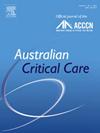Diaphragmatic Rapid Shallow Breathing Index for predicting successful weaning from mechanical ventilation: A systematic review and meta-analysis
IF 2.7
3区 医学
Q2 CRITICAL CARE MEDICINE
引用次数: 0
Abstract
Background
The Diaphragmatic Rapid Shallow Breathing Index (D-RSBI) has been proposed as a promising tool for predicting successful weaning from mechanical ventilation. By focussing on diaphragmatic activity, the D-RSBI aims to overcome the limitations of the classic rapid shallow breathing index, providing a more specific assessment of the patient's ability to sustain independent breathing following extubation.
Methods
Two investigators conducted independent systematic searches in the PubMed, Embase, Cochrane Database, Scopus, Medline, Science Direct, and Epistemonikos databases, covering publications from inception to 30 November 2024. Study quality was assessed using the Quality Assessment of Diagnostic Accuracy Studies 2 tool. A meta-analysis was performed using the random-effect model, calculating sensitivity, specificity, diagnostic odds ratio, and the area under the summary receiver operating characteristic curve for the D-RSBI. The systematic review protocol was registered in the Centre for Reviews and Dissemination database 42024582489 of the Prospective International Registry of Systematic Reviews. Subgroup analyses, bivariate meta-regressions, and sensitivity analyses were conducted. Publication bias was evaluated using a funnel plot, along with Begg's and Egger's tests. The certainty of evidence was assessed using the Grading of Recommendations Assessment, Development, and Evaluation methodology.
Results
Fourteen studies were included in the meta-analysis, comprising a total of 1104 patients. The D-RSBI score was significantly lower in the successful weaning group than in the failure group, with a mean difference of −1.09 (95% confidence interval: -1.36 to −0.82; p < 0.05). The pooled sensitivity was 0.88, specificity was 0.82, and the area under the curve was 0.93. The diagnostic odds ratio was 45.2 (95% confidence interval: 23.5 to 87.2; p < 0.05). The studies included were of moderate to high quality, and the certainty of the evidence was rated as moderate.
Conclusions
The D-RSBI appears to be a promising predictor for forecasting the success of weaning from mechanical ventilation, offering adequate sensitivity and specificity. However, further clinical trials are needed to confirm and validate these findings and thus to establish the score's potential for enhancing the clinical management of weaning in critically ill patients.
预测机械通气成功脱机的膈肌快速浅呼吸指数:一项系统回顾和荟萃分析
横膈膜快速浅呼吸指数(D-RSBI)被认为是预测机械通气成功脱机的一个很有前途的工具。通过关注膈肌活动,D-RSBI旨在克服经典快速浅呼吸指数的局限性,为拔管后患者维持独立呼吸的能力提供更具体的评估。方法两名研究者对PubMed、Embase、Cochrane数据库、Scopus、Medline、Science Direct和Epistemonikos数据库进行了独立的系统检索,涵盖了从成立到2024年11月30日的出版物。使用诊断准确性研究质量评估2工具评估研究质量。采用随机效应模型进行meta分析,计算D-RSBI的敏感性、特异性、诊断优势比和总受者工作特征曲线下面积。该系统评价方案已在前瞻性国际系统评价登记处的评价和传播中心数据库42024582489中注册。进行亚组分析、双变量元回归和敏感性分析。使用漏斗图以及Begg和Egger的检验来评估发表偏倚。证据的确定性采用建议分级评估、发展和评价方法进行评估。结果荟萃分析纳入14项研究,共1104例患者。成功断奶组的D-RSBI评分显著低于失败断奶组,平均差值为- 1.09(95%可信区间:-1.36 ~ - 0.82;p & lt;0.05)。合并敏感性为0.88,特异性为0.82,曲线下面积为0.93。诊断优势比为45.2(95%可信区间:23.5 ~ 87.2;p & lt;0.05)。纳入的研究是中等到高质量的,证据的确定性被评为中等。结论D-RSBI具有足够的敏感性和特异性,是预测机械通气成功脱机的良好预测指标。然而,需要进一步的临床试验来证实和验证这些发现,从而确定该评分在加强危重患者断奶临床管理方面的潜力。
本文章由计算机程序翻译,如有差异,请以英文原文为准。
求助全文
约1分钟内获得全文
求助全文
来源期刊

Australian Critical Care
NURSING-NURSING
CiteScore
4.90
自引率
9.10%
发文量
148
审稿时长
>12 weeks
期刊介绍:
Australian Critical Care is the official journal of the Australian College of Critical Care Nurses (ACCCN). It is a bi-monthly peer-reviewed journal, providing clinically relevant research, reviews and articles of interest to the critical care community. Australian Critical Care publishes peer-reviewed scholarly papers that report research findings, research-based reviews, discussion papers and commentaries which are of interest to an international readership of critical care practitioners, educators, administrators and researchers. Interprofessional articles are welcomed.
 求助内容:
求助内容: 应助结果提醒方式:
应助结果提醒方式:


